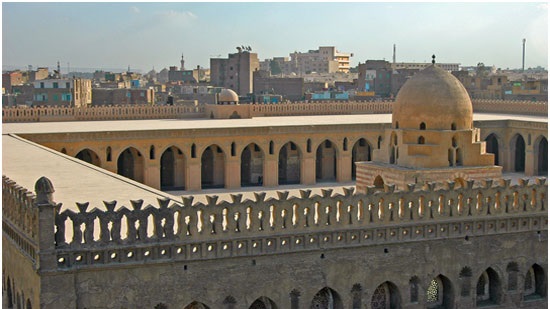When crossing Salah Salem Road at any time of the day, you cannot miss the iconic Citadel of Salah El-Din dominating the eastern edge of the city. One might think this is the best this side of the city has to offer, but there's a world behind the beautiful fortress that holds a fine collection of Cairo's Islamic architectural gems.
Historic El-Khalifa neighbourhood
TEST2
Pictures
14:09
Tuesday ,27 September 2016

Take a small detour off the main Salah Salem road towards Salah El-Din Square and get ready to embark on a special journey through the sites of El-Khalifa neighbourhood.
While many of the nearby districts may be more well-known for their monuments and touristic sites, the streets and nooks of El-Khalifa neighbourhood are perfect for a day-walk if you are looking to see a great collection of monuments and mosques in a less crowded and non-commercial area of Cairo.
Starting off the walk at Salah El-Din Square, you will start noticing the decorative Islamic designs on some of the buildings, and further down the street you cannot miss the remarkable Ottoman landmark resting on a street corner; Sabil Um Abbas.
The landmark was originally built on the orders of Banbah Qadin, the mother of Abbas Helmy I, who ruled Egypt from 1848 to 1854. At the time, sabils were built to serve clean water for passersby as well as serve as a Kutab, or a small educational institution.
Thirteen years after his death, Abbas's mother ordered the construction of this sabil in the honour of her son, whose reign was marked with cruelty and culminated in his assassination.
Though sabils are not uncommon in Cairo, Sabil Um Abbas is particularly splendid. The structure is marked with a beautiful marble facade, with wooden hoods engraved with Arabic calligraphy and Qur'anic verses. The sabil also boasts beautiful bronze window grills and unique marble ornaments, with full-blossomed flowers on its different sides.
The luxurious landmark catches the eye from afar, though sadly it has long been closed to the public.
Amir Taz Palace: Mamluk era
If you take a right at the sabil and walk a few metres down the street, you will come across the entrance to the magnificent Amir Taz Palace at the intersection of Saliba and Siyufiya streets. The palace, which dates back to the Mamluk era and now serves as a cultural centre, is open to the public free of charge.
As you step inside, you find yourself in a courtyard at the centre of the structure, facing the different rooms. Unlike some other historical palaces that still hold the belongings of their original masters, there is not much to see inside the rooms of the Amir Taz Palace. However, the beautifully designed building, with its chandeliers and walls adorned with Arabic calligraphy, is splendid to behold on its own.
Gayer-Anderson House
The Gayer-Anderson House and Museum, also known as Beit El-Keretleya (the House of the Cretan Woman), consists of two connected 16th century houses that hold a beautiful collection of artefacts, furniture, letters, artworks, images and objects that once belonged to the British major and army doctor John Gayer-Anderson.
Gayer-Anderson was a British officer and doctor who first came to Cairo in 1906 as part of his service in the army, eventually settling down in the city in the 1940s.
Gayer-Anderson was a great collector of objets d'art, monuments and furniture from all around the world. The house is notable not only for the objects and unique collection of artefacts that Gayer-Anderson left behind, but also for its architecture, as the residence was made up of two 16-century houses which Gayer-Anderson restored.
Gayer-Anderson, who lived in the house until his death, bequeathed the house and its contents to the Egyptian state, which turned it into a museum.
Unlike many other historical houses or palaces, this museum is one of few that still contain all the well-preserved belongings of the original owners.
Every small detail of the house is a masterpiece in its own right, from the Damascus Room, Queen Anne's Room, the Reading Room to the Haramlek and Salamlek. Even the doorknobs, the library has on its door a small figurine of an angel and on top of it an engraving that says, “Love knocks on your door and love starts”.



